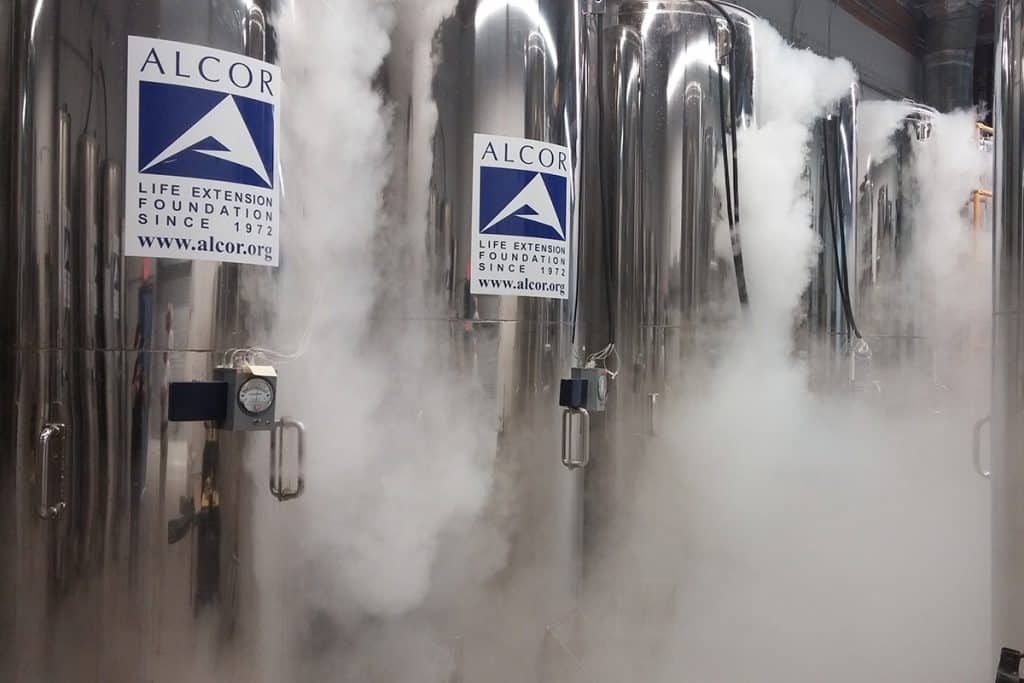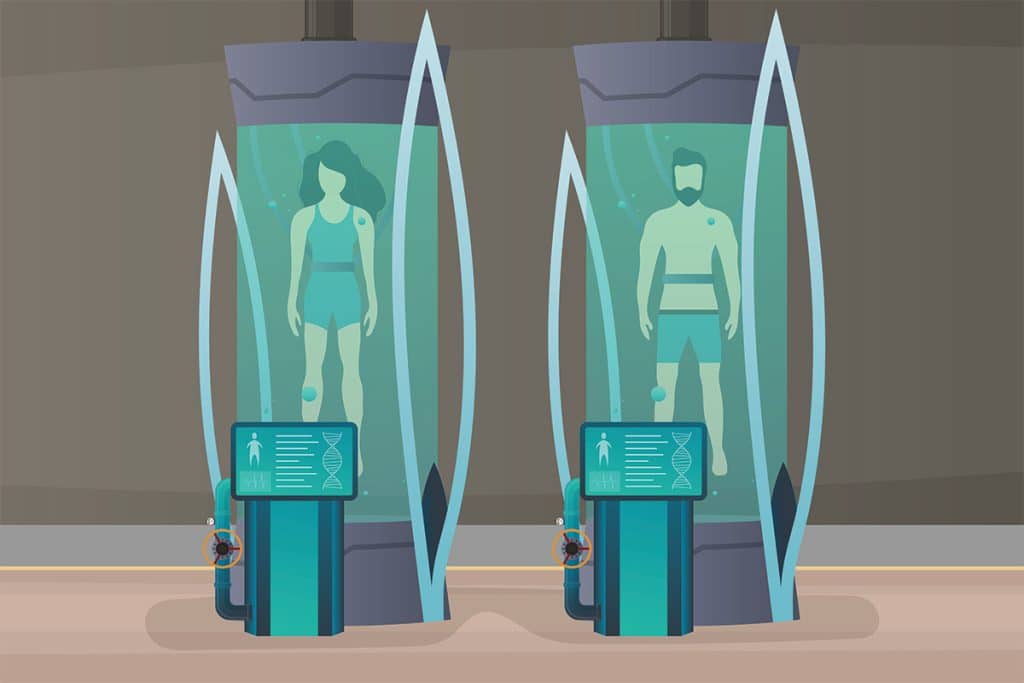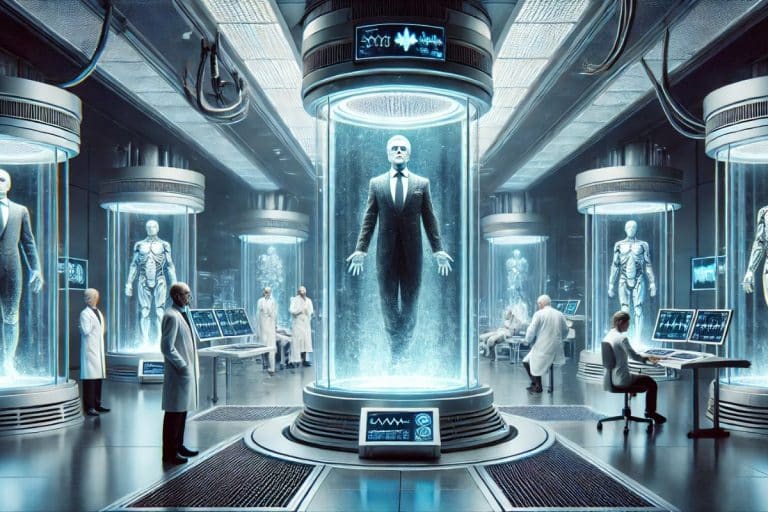Cryogenics has long captured our imagination through science fiction tales of futures where mankind achieves immortality. But for hundreds of people worldwide, this futuristic concept is more than just fantasy – it’s a gamble they’re willing to take in hopes of cheating death.
Today, over 600 individuals have chosen to be cryogenically frozen after legal death, having their bodies cooled to extremely low temperatures for possible revival in a future where medical advances may make previously fatal conditions reversible. With facilities worldwide, cryonics offers an unusual yet advanced service for those who can afford it, the choice to cryogenically freeze with the intent of restoring good health with medical technology in the future.
According to reports by Live Science, “there is no evidence that freezing either the body or the brain and restoring it to a living state is remotely close to viable.” So, why are the rich spending thousands on what can only be considered a scientific experiment?
Cryonics, the practice of deep-freezing human bodies immediately after death with the speculative hope of future revival has long been the stuff of science fiction. However, in recent years it has gained traction among a select group of wealthy individuals who view it as the ultimate insurance policy against mortality.
These cryogenic facilities exist worldwide in countries such as Russia, China, Australia, Switzerland and the US.
With gaining popularity and steady-rising demand, the market share of cryogenics is expected to reach $17.4 billion by 2027. At this moment, over 4,000 people have placed themselves on waiting lists for cryonic preservation.
The waiting list reportedly consists of several well-known names including Simon Cowell, Paris Hilton, Steve Aoki, Britney Spears and Elon Musk.
‘Welcome to your future’
US-headquartered Alcor Life Extension Foundation, founded in 1972, is a cryonics organisation that performs cryopreservation in its facilities where patients are kept in “secure, long-term cryogenic dewars until revival.”

“Welcome to your future,” the website says.
Currently, the foundation has over 1,400 members and 234 patients. The membership package includes a standby medical team, cryopreservation, long-term care and possible revival with the goal of reintegration back into society.
For those who do not intend to commit to whole-body cryopreservation or for those that think it is too expensive, there exists the option of neuropreservation i.e. cryopreservation of the brain in an attempt to restore the patient to health in the future by “regrowing a new body around the brain using future tissue regeneration technology.”
The wealthy are not only considering these services for themselves, members can also choose to cryopreserve their domestic dogs or cats.
The procedure:
- 1-7 days before – A cryonics standby team is waiting near a dying person up to a week in advance.
- 0 hours – The cryopreservation process begins as soon as a person is declared legally dead, at the point where cells and organs are still viable.
- 0-2 hours – Blood circulation and breathing are artificially restored temporarily, to protect the brain and protective medications can be administered intravenously. The patient is then cooled in an ice water bath, and their blood is replaced with an organ preservation solution.
- 0.5-24 hours – The ‘cooled’ patient is transported to the operating room.
- 1-24 hours – Cryoprotectants are perfused into the bloodstream to prevent uncontrolled freezing which could cause damage to the blood, vessels and other organs. The patient is then prepared for cryopreservation.
- 5-7 days – The patient is cooled to -196° C, preserving the patient in a solid state. At this stage, the patient is theoretically ‘protected from deterioration for thousands of years.’
- Long-term care – The patient is stored in a vacuum-insulated metal drawer at subfreezing temperatures with liquid nitrogen, topped up regularly.
- Future – Currently, there is no cryonics organisation that can revive a cryopreserved individual, however, companies continue care in hope that revival may become possible with future medical technologies.
Earlier this year, the world’s first cryonics museum emerged in Colorado, housing a cryogenically frozen man named Bredo Morstoel. The cylindrical steel chamber stands in the museum with the aim to educate the public about the science of cryogenic preservation.
As most may wonder – How much does it cost for a scientific process of such length? A member can expect to pay anywhere between $28,000 for neuropreservation and over $200,000 for whole-body cryopreservation. With these staggering rates, it is clear that this is a service primarily accessible to the wealthy.
Annual storage fees and the need for substantial life insurance policies to cover future revival costs further restrict access to those with significant financial means.
The Walt Disney ‘Frozen’ conspiracy
Several reports and online conspiracy theorists claim that Walt Disney was one of the first to be cryogenically frozen with rumours saying that either his head or whole body is currently preserved under Disneyland’s Pirates of the Caribbean ride, needless to say, there is no clear evidence to back any such claims.

According to Ripley’s Believe it or Not, biographies written about Disney following his demise cited his interest in cryogenics, although discredited for their speculative nature.
“Disney’s growing preoccupation with his own mortality also led him to explore the science of cryogenics, the freezing of an aging or ill person until such time as the human body can be revived and restored to health,” a passage read.
As speculations developed, a second conspiracy theory came about stating that Disney released the movie ‘Frozen’ to divert searches of ‘Walt Disney frozen’ to the movie rather than cryogenic-related articles.
However, as per official statements and records, Disney was cremated and his memorial park stands at Forest Lawn in Los Angeles.
Legal complexities
While cryonics enthusiasts vouch for the technology as a gateway to revival, the legal ramifications remain present, complex and mostly uncharted territory. The legal challenges posed by successful reanimation are as intricate as the preservation process itself, raising fundamental questions about personhood and legal identity.
Cryopreservation can only legally begin after a person is declared dead, creating a unique conundrum should future revival succeed. This scenario essentially proposes a legal resurrection, a concept entirely foreign to current legal frameworks.
Questions prevail such as; will the legal identity of the person remain the same? How would past contracts, debts and other legal commitments be handled? Would a revived person have any claim to former possessions? These are just some of the complexities in a web of legalities.
‘Cryonic refugees’
A potential outcome is the creation of “cryonic refugees” – individuals awakening in a future society with no assets, no social connections, and potentially outdated skills. This presents significant social and economic challenges that current legal and social systems are not currently equipped to handle.

According to a paper titled The cryonic refugee: appropriate analogy or confusing rhetoric? by Richard B. Gibson, “The possibility of the post-cryopreserved supporting themselves, both economically and socially, is dubious; they will likely need state assistance. What a future society owes the post-cryopreserved, and why, remains unclear. One potential solution is to consider revivals as comparable to refugees, with the latter fleeing spatially and the former fleeing temporally. But, the appropriateness of the ‘cryonic refugee’ remains unconsidered.”
Some cryonics facilities, particularly in the United States, have proposed using long-term trusts as a workaround.
Alcor created the Alcor Model Revocable Asset Preservation Trust for members to present to an estate planner, financial planner or attorney. This approach, however, faces its own set of challenges. The concept of a trust lasting centuries for a potentially reanimated beneficiary is currently beyond the scope of most legal systems.
Moreover, even if such trusts were legally viable, there’s no guarantee that the assets would retain value or relevance in an unknowable future economy.
According to Cryonics, euthanasia, and the doctrine of double effect, published in June 2023 by Gabriel Andrade and Maria Campo Rednodo, “Cryonics is seldom taken seriously because of its alleged poor technological feasibility. But if the history of technology is any guide, such conclusions may be premature, and the jury is still out whether cryonics is hype or hope.”
Since 2023 until now, Alcor has cryopreserved 10 patients, as revealed in a list of non-confidential cryopreserved patients.
While the science remains speculative and the ethical debates continue, one thing is clear: in the world of the ultra-rich, the pursuit of immortality through technology is no longer just a flight of fancy. It’s a cold, hard reality – for now.








